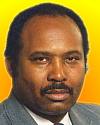
Born 16 Nov 1943.
Black American chemist who is best known for advancing the accuracy of trace element analyses. With his collaborators at Bell Labs, he pioneered the development of x-ray fluorescence methods for part per billion (ppb) trace element determinations, innovated high accuracy activation analysis methods for ultratrace analysis, designed the first laser intracavity spectrophotometer for high accuracy practical determinations of sub-ppb levels of trace impurities, and invented the cryogenic sublimation technique for ultrapurification of liquid analytical reagents and chemicals for fabricating optical waveguides. He is currently exploring ways to apply his ultra-precise measuring procedures to detect trace amounts of contaminants in our air and water.
Black American chemist who is best known for advancing the accuracy of trace element analyses. With his collaborators at Bell Labs, he pioneered the development of x-ray fluorescence methods for part per billion (ppb) trace element determinations, innovated high accuracy activation analysis methods for ultratrace analysis, designed the first laser intracavity spectrophotometer for high accuracy practical determinations of sub-ppb levels of trace impurities, and invented the cryogenic sublimation technique for ultrapurification of liquid analytical reagents and chemicals for fabricating optical waveguides. He is currently exploring ways to apply his ultra-precise measuring procedures to detect trace amounts of contaminants in our air and water.
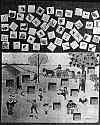
Born 16 Nov 1884; died 7 Nov 1942 at age 57.
English-American psychologist who combined interests in mental measurements and education of people with disabilities. His performance assessment measures supplied half of the items of the World War I Army Beta Test. He directed many surveys in his field and wrote a number of scientific works. A Scale of Performance Tests (1917) by Rudolf Pintner and Donald G. Paterson, introduced the Pintner-Paterson Performance Test, the first test of nonverbal intelligence. It was intended as a "supplemental" test to the 1908 Binet battery (which they criticized as unwarrantably favorable to the verbal aspects of individual intelligence). They insisted that there was more than one aspect of intelligence and more than one way of measuring it.[Image: Picture Completion puzzle, part of the Pintner & Paterson's clinical style performance scale (1917)]
English-American psychologist who combined interests in mental measurements and education of people with disabilities. His performance assessment measures supplied half of the items of the World War I Army Beta Test. He directed many surveys in his field and wrote a number of scientific works. A Scale of Performance Tests (1917) by Rudolf Pintner and Donald G. Paterson, introduced the Pintner-Paterson Performance Test, the first test of nonverbal intelligence. It was intended as a "supplemental" test to the 1908 Binet battery (which they criticized as unwarrantably favorable to the verbal aspects of individual intelligence). They insisted that there was more than one aspect of intelligence and more than one way of measuring it.[Image: Picture Completion puzzle, part of the Pintner & Paterson's clinical style performance scale (1917)]
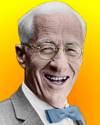
Born 16 Nov 1881; died 30 Apr 1983 at age 101. quotes
U.S. educator and chemist whose monograph Solubility (1924; later editions, Solubility of Non-Electrolytes) was the classic reference for almost a half century. The Hildebrand solubility parameter carries his name. Through his research on the chemistry of solutions, he helped to protect deep-sea divers from “bends.” He led the fight against a faculty “loyalty oath,” a non-Communist declaration, at University of California (1950). He had no sympathy with Communists, but he and other prominent members of the faculty felt that the oath, by being required of teachers alone, was discriminatory with regard to all university employees. Two years later, the California State Supreme Court decided unanimously in favour of the faculty.
U.S. educator and chemist whose monograph Solubility (1924; later editions, Solubility of Non-Electrolytes) was the classic reference for almost a half century. The Hildebrand solubility parameter carries his name. Through his research on the chemistry of solutions, he helped to protect deep-sea divers from “bends.” He led the fight against a faculty “loyalty oath,” a non-Communist declaration, at University of California (1950). He had no sympathy with Communists, but he and other prominent members of the faculty felt that the oath, by being required of teachers alone, was discriminatory with regard to all university employees. Two years later, the California State Supreme Court decided unanimously in favour of the faculty.

Born 16 Nov 1852; died 25 Jan 1932 at age 79.
Maximilian Ruppert Franz von Frey was an Austrian physiologist who studied the sense of touch, providing the first comprehensive information about the cutaneous senses. He confirmed the existence of locations for heat, cold, pressure, and pain reception and studied differential sensitivities to each. He suggested a sensory receptor for each modality but later work showed these identifications to be incorrect.[Image: Sphygmograph used for pulse recording by Frey, 1891]
Maximilian Ruppert Franz von Frey was an Austrian physiologist who studied the sense of touch, providing the first comprehensive information about the cutaneous senses. He confirmed the existence of locations for heat, cold, pressure, and pain reception and studied differential sensitivities to each. He suggested a sensory receptor for each modality but later work showed these identifications to be incorrect.[Image: Sphygmograph used for pulse recording by Frey, 1891]
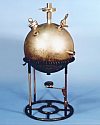
Born 16 Nov 1841; died 12 Sep 1923 at age 81.
French physicist who made the first high-altitude determination of the solar constant (1875, on Mont Blanc in the French-Swiss Alps). He also determined the fusion points of palladium, platinum and gold. Violle also was interested in the theory of geysers, the origin of hail, and atmospheric exploration through balloon soundings. For high-temperature radiation, he proposed a photometric unit, the violle or Violle's standard (1881). His actinometer is one form of pyrheliometer, a device to measure the intensity of sunlight. It was modified from John Herschel's invention of 1825. It consists of two concentric hollow spheres containing water between them. Sunlight passes through an aperture and falls on a thermometer bulb in the hollow inner sphere.
French physicist who made the first high-altitude determination of the solar constant (1875, on Mont Blanc in the French-Swiss Alps). He also determined the fusion points of palladium, platinum and gold. Violle also was interested in the theory of geysers, the origin of hail, and atmospheric exploration through balloon soundings. For high-temperature radiation, he proposed a photometric unit, the violle or Violle's standard (1881). His actinometer is one form of pyrheliometer, a device to measure the intensity of sunlight. It was modified from John Herschel's invention of 1825. It consists of two concentric hollow spheres containing water between them. Sunlight passes through an aperture and falls on a thermometer bulb in the hollow inner sphere.
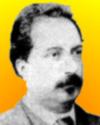
Born 16 Nov 1835; died 18 Feb 1900 at age 64. quotes
Italian mathematician and mathematical physicist known for his concepts of non-Euclidean geometry. In 1865, he published a paper on how line elements on the surfaces of constant curvature could be represented by linear expressions. His approach offered a new representation of the geometry of constant curvature that was consistent with Euclidean theory. Beltrami studied elasticity, wave theory, optics, thermodynamics, and potential theory, and was among the first to explore the concepts of hyperspace and time as a fourth dimension. His investigations in the conduction of heat led to linear partial differential equations. Some of Beltrami's last work was on a mechanical interpretation of Maxwell's equations.
Italian mathematician and mathematical physicist known for his concepts of non-Euclidean geometry. In 1865, he published a paper on how line elements on the surfaces of constant curvature could be represented by linear expressions. His approach offered a new representation of the geometry of constant curvature that was consistent with Euclidean theory. Beltrami studied elasticity, wave theory, optics, thermodynamics, and potential theory, and was among the first to explore the concepts of hyperspace and time as a fourth dimension. His investigations in the conduction of heat led to linear partial differential equations. Some of Beltrami's last work was on a mechanical interpretation of Maxwell's equations.
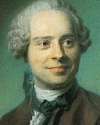
Born 16 Nov 1717; died 29 Oct 1783 at age 65. quotes
French mathematician known for his work in various fields of applied mathematics, in particular dynamics. In 1743 he published his Traité de dynamique (Treatise on Dynamics). The d’Alembert principle extends Newton’s third law of motion, that Newton's law holds not only for fixed bodies but also for free moving bodies. D’Alembert also wrote on fluid dynamics, the theory of winds, the properties of vibrating strings and conducted experiments on the properties of sound. His most significant purely mathematical innovation was his invention and development of the theory of partial differential equations. He published eight volumes of mathematical studies (1761-80). He was editor of the mathematical and scientific articles for Denis Diderot's Encyclopédie.
French mathematician known for his work in various fields of applied mathematics, in particular dynamics. In 1743 he published his Traité de dynamique (Treatise on Dynamics). The d’Alembert principle extends Newton’s third law of motion, that Newton's law holds not only for fixed bodies but also for free moving bodies. D’Alembert also wrote on fluid dynamics, the theory of winds, the properties of vibrating strings and conducted experiments on the properties of sound. His most significant purely mathematical innovation was his invention and development of the theory of partial differential equations. He published eight volumes of mathematical studies (1761-80). He was editor of the mathematical and scientific articles for Denis Diderot's Encyclopédie.
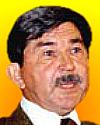
1983
Died 16 Nov 2005 at age 89 (born 30 Nov 1915). quotes
Canadian-born American chemist who in 1983 won the Nobel Prize for Chemistry for his extensive research into the properties and reactions of dissolved inorganic substances, particularly oxidation-reduction processes involving the ions of metallic elements. Metals often form complexes, in which other atoms cluster around the metal atom, transfering and sharing electrons among themselves to bind together. Taube discovered that during a reaction, a temporary “bridge” of atoms often forms between metal atoms. He studied the electron transfer across this bridge, speeding up reactions that would otherwise happen only slowly or not at all. His ideas are relevant beyond his own field of study, for example, in biochemical processes such as respiration.
Canadian-born American chemist who in 1983 won the Nobel Prize for Chemistry for his extensive research into the properties and reactions of dissolved inorganic substances, particularly oxidation-reduction processes involving the ions of metallic elements. Metals often form complexes, in which other atoms cluster around the metal atom, transfering and sharing electrons among themselves to bind together. Taube discovered that during a reaction, a temporary “bridge” of atoms often forms between metal atoms. He studied the electron transfer across this bridge, speeding up reactions that would otherwise happen only slowly or not at all. His ideas are relevant beyond his own field of study, for example, in biochemical processes such as respiration.
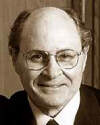
Died 16 Nov 1999 at age 71 (born 30 Oct 1928).
American microbiologist, corecipient of the Nobel Prize for Physiology or Medicine in 1978 (with American Hamilton Othanel Smith and Swiss scientist Werner Arber). The winners were cited for their discovery and application of restriction enzymes, which provide the "chemical knives" to cut genes (= DNA) into defined fragments. These may then be used (1) to determine the order of genes on chromosomes, (2) to analyse the chemical structure of genes and of regions of DNA which regulate the function of genes, and (3) to create new combinations of genes. Thus new avenues are opened to study the basic problems in developmental biology; and in medicine, to help the prevention and treatment of malformations, hereditary diseases and cancer.
American microbiologist, corecipient of the Nobel Prize for Physiology or Medicine in 1978 (with American Hamilton Othanel Smith and Swiss scientist Werner Arber). The winners were cited for their discovery and application of restriction enzymes, which provide the "chemical knives" to cut genes (= DNA) into defined fragments. These may then be used (1) to determine the order of genes on chromosomes, (2) to analyse the chemical structure of genes and of regions of DNA which regulate the function of genes, and (3) to create new combinations of genes. Thus new avenues are opened to study the basic problems in developmental biology; and in medicine, to help the prevention and treatment of malformations, hereditary diseases and cancer.
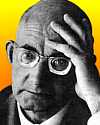
Died 16 Nov 1982 at age 86 (born 25 Apr 1896). quotes
Pavel Sergeevich Aleksandrov (or Alexandroff) was a Soviet mathematician who made important contributions to the field of topology (the study of related physical or abstract elements that remain unchanged under certain distortions) and one of the founders of the theory of compact and bicompact spaces. Aleksandrov introduced many of the basic concepts of topology, such as the notion that an arbitrarily general topological space can be approximated to an arbitrary degree of accuracy by simple geometric figures such as polyhedrons. Giving support to international cooperation, he supervised the publication of an English-Russian dictionary of mathematical terminology (1962).[Note: birth date 25 April 1896 Old Style is 7 May 1896 New Style.]
Pavel Sergeevich Aleksandrov (or Alexandroff) was a Soviet mathematician who made important contributions to the field of topology (the study of related physical or abstract elements that remain unchanged under certain distortions) and one of the founders of the theory of compact and bicompact spaces. Aleksandrov introduced many of the basic concepts of topology, such as the notion that an arbitrarily general topological space can be approximated to an arbitrary degree of accuracy by simple geometric figures such as polyhedrons. Giving support to international cooperation, he supervised the publication of an English-Russian dictionary of mathematical terminology (1962).[Note: birth date 25 April 1896 Old Style is 7 May 1896 New Style.]
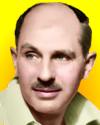
Died 16 Nov 1964 at age 66 (born 21 Jun 1898). quotes
American botanist, naturalist and author who won high critical acclaim for his several books on plant life and nature. After college, he joined the U.S. Department of Agriculture as a botanist in the office of foreign seed and plant introduction. From 1922-3 he worked on frost resistance in tropical plants. In 1926, he left the USDA to free-lance in his own field, writing books and also began a nature column in the Washington Star which ran for 10 years. An example of his writing for lay people, his book Flowering Earth (1939, reprinted 1991) reveals the miracle of plant life. Needing no chemical formulas or botanical glossary, it involves the reader in the vital stories of chlorophyll and of protoplasm, of algae and seaweeds, conifers and cycads.
American botanist, naturalist and author who won high critical acclaim for his several books on plant life and nature. After college, he joined the U.S. Department of Agriculture as a botanist in the office of foreign seed and plant introduction. From 1922-3 he worked on frost resistance in tropical plants. In 1926, he left the USDA to free-lance in his own field, writing books and also began a nature column in the Washington Star which ran for 10 years. An example of his writing for lay people, his book Flowering Earth (1939, reprinted 1991) reveals the miracle of plant life. Needing no chemical formulas or botanical glossary, it involves the reader in the vital stories of chlorophyll and of protoplasm, of algae and seaweeds, conifers and cycads.
Flowering Earth, by Donald Culross Peattie. - book suggestion.
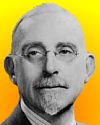
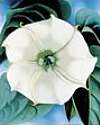
American botanist and geneticist whose international recognition began with his Ph.D. degree thesis on his discovery of sexuality in the lower fungi (Sexual Reproduction in the Mucorineae, 1904) was significant to the understanding of sexual reproduction of the lower plants. His study of the mutation and geographical distribution of the jimson weed, Datura, provided important information concerning chromosome behavior, genetic balance, and species evolution. He discovered that the alkaloid colchicine causes chromosone duplication in plants—the first demonstration of chemical mutagenesis—which led to commercial production of giant strains of flowers.«[Image right: Jimson weed.]
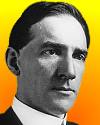
Died 16 Nov 1948 at age 71 (born 10 Jan 1877).
American educator and scientist who invented the industrial electrostatic precipitator (1907), which eliminates suspended particles from streams of gases. He patented the “Art of Separating Suspended Particles from Gaseous Bodies” (No. 895,729). To electrochemists, he is best known for the Cottrell equation. Electrostatic precipitators are still widely used to reduce air pollution by smoke from power plants and dust from cement kilns and other industrial sources. Cottrell contributed to the development of a process for the separation of helium from natural gas, and also was instrumental in establishing the synthetic ammonia industry in the U.S. during attempts to perfect a high temperature process for formation of nitric oxide.
American educator and scientist who invented the industrial electrostatic precipitator (1907), which eliminates suspended particles from streams of gases. He patented the “Art of Separating Suspended Particles from Gaseous Bodies” (No. 895,729). To electrochemists, he is best known for the Cottrell equation. Electrostatic precipitators are still widely used to reduce air pollution by smoke from power plants and dust from cement kilns and other industrial sources. Cottrell contributed to the development of a process for the separation of helium from natural gas, and also was instrumental in establishing the synthetic ammonia industry in the U.S. during attempts to perfect a high temperature process for formation of nitric oxide.
Cottrell, Samaritan of Science, by Frank Cameron. - book suggestion.
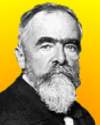
1932
Died 16 Nov 1934 at age 92 (born 11 Jun 1842).
German chemist, engineer and inventor who invented mechanical refrigeration. His first refrigeration equipment was tested in a Munich brewery. Brewing good lager beer required low temperatures, limiting brewing to winter, or in deep cellars with the use of large quantities of block ice. Through Linde's invention of refrigeration, beer brewing became seasonally independent. Linde also invented a continuous process of liquefying gases in large quantities which provided both impetus and means for conducting scientific research at low temperatures and very high vacuums. Linde's original industry has now grown to 120 companies around the world.
German chemist, engineer and inventor who invented mechanical refrigeration. His first refrigeration equipment was tested in a Munich brewery. Brewing good lager beer required low temperatures, limiting brewing to winter, or in deep cellars with the use of large quantities of block ice. Through Linde's invention of refrigeration, beer brewing became seasonally independent. Linde also invented a continuous process of liquefying gases in large quantities which provided both impetus and means for conducting scientific research at low temperatures and very high vacuums. Linde's original industry has now grown to 120 companies around the world.
Linde: History of a Technology Corporation, 1879-2004, by Hans-Liudger Dienel. - book suggestion.
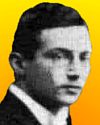
Died 16 Nov 1922 at age 47 (born 26 Mar 1875).
German physicist whose life work was almost all related to Maxwell's theory. The text he wrote was the standard work on electrodynamics in Germany for a long time. Throughout his life, he remained strongly opposed to Einstein's Theory of Relativity, objecting to its postulates which he felt were contrary to classical common sense. He further held that the experimental evidence did not support that theory. In 1902, he had developed a theory of the electron in which he held that an electron was a perfectly rigid sphere with a charge distributed evenly over its surface. He also believed in the ether theory, thought that future astronomical data would validate it, and thus relativity was not in fact a good description of the real world.
German physicist whose life work was almost all related to Maxwell's theory. The text he wrote was the standard work on electrodynamics in Germany for a long time. Throughout his life, he remained strongly opposed to Einstein's Theory of Relativity, objecting to its postulates which he felt were contrary to classical common sense. He further held that the experimental evidence did not support that theory. In 1902, he had developed a theory of the electron in which he held that an electron was a perfectly rigid sphere with a charge distributed evenly over its surface. He also believed in the ether theory, thought that future astronomical data would validate it, and thus relativity was not in fact a good description of the real world.
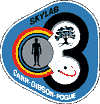
In 1972, Skylab III, carrying a crew of three astronauts, was launched from Cape Canaveral, Fla., on an 84-day mission that remained the longest American space flight for over two decades (until Norm Thagard broke it aboard Mir in 1995 and Shannon Lucid, Feb 2002-Sep 2003). The Skylab III crew, Gerald P. Carr, William R. Pogue and Edward C. Gibson, maintained their physical condition by walking treadmills and riding an on-board stationary bicycle. Among the thousands of experiments conducted during this flight, the astronauts took four space walks, including one on Christmas Day to observe the comet Kohoutek. After 1214 orbits, the crew returned to Earth, splashing down on 8 Feb 1974.
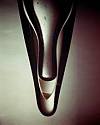
In 1945, two newly discovered elements were announced: americium (atomic number 95) and curium (atomic number 96).*Americium, named after the Americas, can be produced from intense neutron irradiation of pure plutonium. Problems involved in the extraction of americium include the recovery of the expensive starting material and the removal of hazardous fission products that are formed simultaneously in amounts comparable to the amounts of the element itself. It was discovered by Glenn Seaborg, James, Morgan and Albert Ghiorso in Chicago, U.S.A. It is used as a portable source for gamma radiography, and in smoke detectors. Curium, a byproduct of americium, was named in honour of Pierre and Marie Curie.[Image: The triangle in the glass tube contains the world's first sample of americium, produced in the 60- inch cyclotron in 1944]
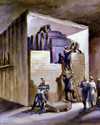
In 1942, work began on an experimental atomic pile to investigate the world's first artificial nuclear chain reaction. In a makeshift lab underneath the University's football stands at Stagg Field, physicists and staffers, worked around the clock to built a lattice of 57 layers of uranium metal and uranium oxide embedded in graphite blocks. A wooden structure supported the graphite pile. The research would be an important contribution to the Manhattan Project, a secret wartime project to develop nuclear weapons, which initiated the modern nuclear age. Little more than two weeks later, on 2 Dec 1942, the first self-sustained nuclear chain reaction was achieved by Enrico Fermi and his team.«
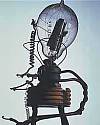
In 1904, the first electron tube, a diode thermionic valve, was invented by John Ambrose Fleming. The valve consists of a carbon or tungsten filament lamp, to which is added a metal plate (insulated from the filament), and a connecting wire brought through the glass wall of the bulb to a third terminal outside. When battery current is applied to the filament making it incandescent, the space between the filament and the insulated plate will be found to conduct elecrons in only one direction. That means if the valve is connected in a circuit in with an oscillating current, its one-way conductivity will convert the oscillating current into a unidirectional current capable of actuating a telephone receiver. He notified Marconi in a 30 Nov 1904 letter.
In 1901, the first American racer to exceed the speed of a mile a minute (60 mph) was that of A.C. Bostwick on the Ocean Parkway racetrack in Brooklyn, New York. During a race sponsored by the Long Island Automobile Club, Bostwick achieved an average speed of 63.83 mph along a one-mile straightaway on the course, thus completing the mile in 56.4 seconds. European car manufacturers and drivers dominated early motor racing, a phenomenon reflected in the first seven speed records. However, in 1902, just under a year after Bostwick's historic run, William K. Vanderbilt, Jr., a businessman and racing enthusiast, became the first American to enter the land speed record books when he ran a mile in 47.32 seconds, or at an average speed of 76.086 mph. The Mors automobile that Vanderbilt drove was also the first vehicle with an internal combustion engine to enter the speed record books. [Another source says - Henry Fournier drove a mile in 51 4/5 seconds, becoming the first auto racer to drive more than a mile-a-minute in competition - in Brooklyn, New York.]*
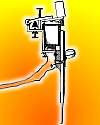
(USPTO)
In 1875, the first U.S. patent for a dental mallet, or "Electro-magnetic Dental Pluggers" was issued to William G.A. Bonwill of Philadelphia, Pa. (No. 170,045). His tooth-filling device was used to drive gold into a tooth cavity. He derived the idea from observing the sounder of a telegraph key (while at the Continental Hotel in Philadelphia, 27 Feb 1867). The automatic tool was designed to be "manipulated as readily as the usual hand-tools." An electromagnet functions to drive a mallet, while also breaking the circuit to allow the spring-loaded mallet to return, at which point the circuit is closed, and the cycle repeated under the control of the operator.* more
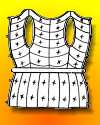
(USPTO)
In 1841, the first patent for a U.S. life preserver of cork was issued to Napoleon E. Guerin of New York City (No. 2,359) for his "Improvement in Buoyant Dresses or Life-Preservers." It was of the form of a jacket or waistcoat. The jacket was described as being made from a doubled layer of material, with sufficient room for the introduction of from 18 to 20 quarts of rasped or grated cork. After the insertion of the rasped or grated cork between the layers, those parts of the garment left open would be sewn closed. The difference in quantity of cork was chosen according to the size of the person for whom the life preserver is to be made.*
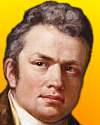
In 1796, inventor and engineer Marc Brunel was issued his first U.S. patent for his method of “Ruling Books and Paper.” He obtained other U.S. patents, including for a “Machine for Writing With Two Pens” (17 Jan 1799), “Machine For Raising Water” (27 Apr 1798) and “Mode of Obtaining Power from Certain Fluids” (30 Mar 1827). He was born in France (1769), but fled the Revolution and spent six years in America. By the 1790s, he was architect and chief engineer for New York City. In Mar 1799 he moved to England and expanded his career. Brunell is famous for his construction of the Thames Tunnel, in London, the first tunnel excavated under a navigable river. His son, Isambard Kingdom Brunel, also had a distinguished engineering career producing railroads, bridges and steamships.«
In 1786, the first U.S.-made "jenny" and "stock-card" machines were supported by the Massachusetts state legislature. The legislature voted a grant of £200 for the completion of what are believed to be first U.S.-made spinning, carding, and roping machines. In his workshop at Bridgewater, Mass, senator Hugh Orr employed brothers Robert and Alexander Barr, machinists bringing knowledge about such machines from Scotland. The senate subsequently awarded the Barrs six tickets in the state land lottery of the time (in which there were no blanks), as a reward for their "ingenuity " and " public spirit."*The machines, known as "The State Models" were advertised so that the early American textile-machinery manufacturers could benefit.
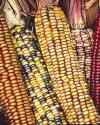
In 1620, the first corn (maize) found in the U.S. by British settlers was discovered in Provincetown, Mass., by sixteen desperately hungry Pilgrims led by Myles Standish, William Bradford, Stephen Hopkins, and Edward Tilley at a place they named Corn Hill. The food came from a previously harvested cache belonging to a local Indian tribe. This corn provided a much needed supply of food which saw the Pilgrims through their first Winter in the New World. A commemorative plaque placed on Corn Hill quotes in part “And sure it was God's good providence that we found this corn for else we know no how we should have done.” The date 16 Nov is according to the Old Style Calendar.




